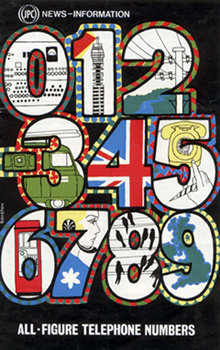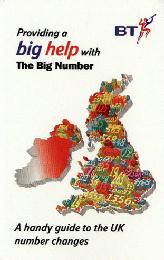 |
UK Numbering History |
A brief overview of code types, past and present throughout the UK.
London Codes
Letters & Numbers
Between the introduction of Director exchanges (1927) and the conversion to All-Figure Numbers (1966), telephone numbers in London used a 3 letter name code followed by the 4 digit subscriber's number, e.g. Whitehall WHI 1234.
See examples of codes...(later London 1928 London 1960 London 1968)
All-Figure Numbering (Director Areas)
 |
 |
 |
UK Numbering History |
This process was not completed until the end of 1969. The Post Office Telecommunications Journal of Winter 1969 reported: "The introduction of all-figure telephone numbers in six major cities is now in its final stages..."
"...The letter codes will be withdrawn in London from January 1970 in batches of about six a month, and callers to these exchanges using the old letter code will hear a recorded announcement for three months. After that, for about nine months, they will be connected to the number unobtainable tone. In other cities the old codes will be withdrawn gradually from April 1970."
071/081
6th May 1990 saw the split of the London area code (01) into (071) inner London and (081) outer London. This was to cater mainly for the high demand for additional Business Lines, e.g for faxes etc in the capital city. Parallel running, when both old and new codes could be dialled was between 2nd April and 5th May 1990. From 6th May, callers dialling 01 received a recorded announcement advising then to re-dial using the new codes. Indeed among Residential customers there was some snobbery in being associated with the two parts of the capital and the Maureen Lipman "Beattie" adverts used this to good effect in promoting the split. After the changeover the full 10 digit number had to be dialled when calling from an 071 to 081 number and vice versa - London was now divided.
0171/0181
PhONEday began at 1.00am on Sunday 16th April 1995 when an extra digit (1) was added to most of the UK's dialling (NNG) codes. London codes became 0171 and 0181 respectively.
020 7xxx /020 8xxx
The Big Number - Finally, after 14th October 2000, when parallel running of the old codes ended, London once again had a single code (020).
020 7XXX XXXX and 020 8XXX XXXX is the correct format. So many people wrongly show this as 0207 or 0208.
PhONEday
 |
PhONEday began at 1.00am on Sunday 16th April 1995 when an extra digit (1) was added to most of the UK's dialling (NNG) codes. |
 |
In the late 1990s, the demand for numbers was relentless and continued to outstrip supply. Six cities were to have both code and number changes. |
| place for scan | April 1985 saw the launch of local rate and freephone numbers in the UK. Previously any free calls had to be connected via the operator, and so this new concept of charging was provided via an overlay network. |
 |
The closing of local dialling allows subscriber numbers beginning with '0' to be allocated in future. |
For more information on numbering:
www.ofcom.org.uk/
www.rod.sladen.org.uk/telephon.htm
All logos and trade marks are the property of their respective owners and are used on the Light Straw site(s) for review only. Students and researchers are recommended to make their own independent enquiries as to the accuracy of the information contained therein.